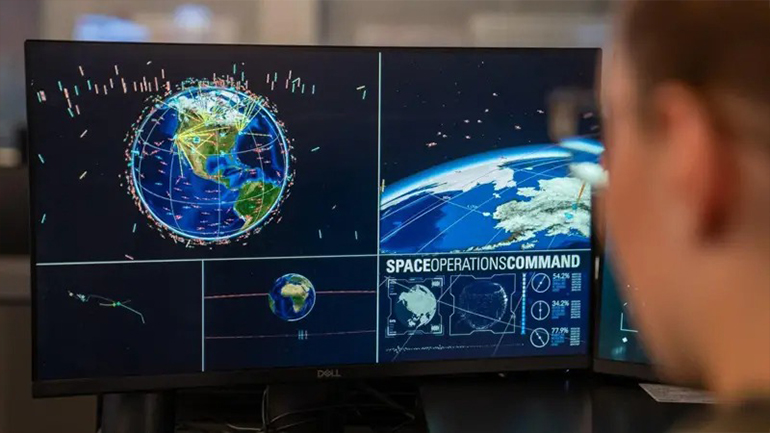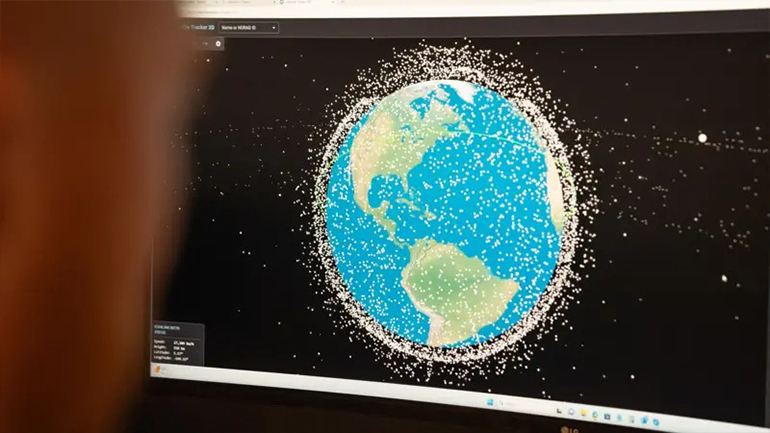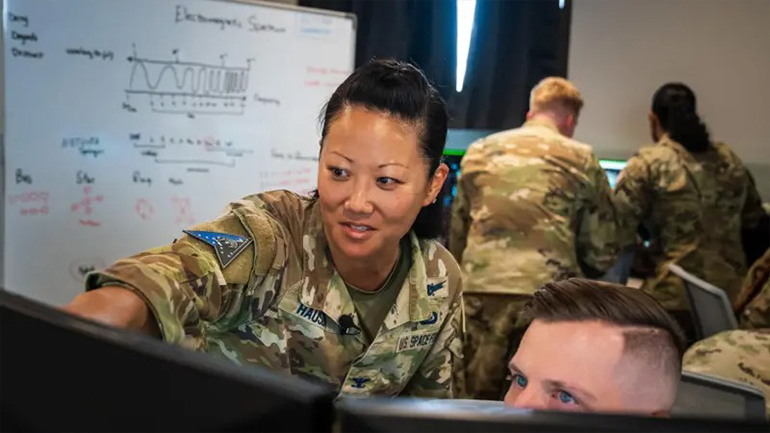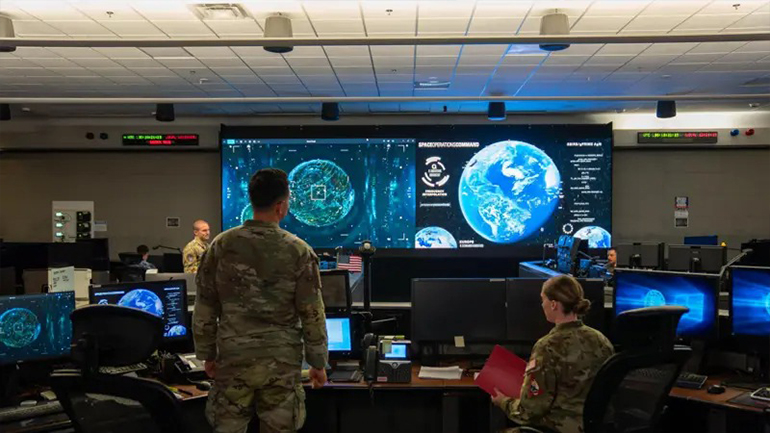

The moment the command was heard, the personnel seated at the computers — part of the U.S. Space Force missile detection unit — responded in unison: “Copy, launch Yemen.” In the U.S. Space Force, the individuals monitoring computer screens are not called soldiers — they are referred to as Guardians, a title unique to this modern space and defense unit, which specializes in infrared missile tracking and satellite surveillance. Seated in front of advanced systems in Colorado, these Guardians are capable of detecting missile launches from anywhere in the world. From the moment a missile is fired to the moment it strikes its target, they can track its trajectory using space-based military satellites. The international media were granted exclusive access to the Buckley Space Force Base, where the U.S. Space Force operates its top-secret missile warning and tracking operations room. Inside this high-security room, large screens display real-time satellite maps and data feeds from orbiting systems that monitor Earth’s atmosphere. Whenever a missile is launched, the Guardians are the first to detect it through its infrared heat signature. During our visit, a simulated alert — “Launch Iran” — rang out, immediately followed by a confirmation: “Copy, launch Iran.” Though this was just a missile tracking drill, it closely mirrored real-world events. Just last month, during a retaliatory strike by Iran, when ballistic missiles targeted the U.S. military base in Al Udeid, Qatar, the Guardians sprang into real-time action. Colonel Anne Hughes explained that the operations room was a tense environment. Unlike surprise attacks, they had prior intelligence and successfully tracked the incoming Iranian missiles, sharing crucial targeting data with ground-based air defense systems. “We were ultimately able to protect the Al Udeid base and ensure the safety of all U.S. forces stationed there,” she stated.

The US Space Force can track missiles launched anywhere in the world.
Colonel Hughes states that in recent years, due to ongoing wars in the Middle East and Europe, her unit has remained extremely busy. When asked whether her unit has also been providing advance missile warnings to Ukraine, Colonel Hughes responded, “We provide strategic and tactical warnings to all U.S. and allied forces.” Although the U.S. government does not openly confirm this, it appears likely that they have been warning Ukraine about Russian missile attacks. The Buckley Space Force Base is expected to become a critical part of former President Donald Trump’s ambitious missile defense program, known as the Golden Dome. Inspired by Israel’s Iron Dome, the Golden Dome project has been allocated $175 billion in funding, although many believe the actual cost will be significantly higher. Construction has already begun at Buckley. Radomes have been installed to protect the powerful satellite dishes located at the base. From a distance, these dome-shaped radomes look like golf balls, but they are protective covers for sensitive satellite systems. These advanced satellite sensors have even been able to detect radio frequencies emitted from supernovae located 11,000 light-years away. Lieutenant General David Miller, the head of U.S. Space Operations Command, says the Golden Dome project — still in its early phases — is a clear sign of America’s growing concerns over strategic threats. He specifically mentions China and Russia, stating that both countries have developed hypersonic missiles capable of flying at five times the speed of sound. Additionally, they have tested fractional orbital bombardment systems, which are difficult to detect with conventional radar. General Miller emphasizes that intercepting these advanced weapons may require placing interceptors in space, adding that rather than focusing on weaponizing space, the U.S. should focus on building "capabilities" to defend its interests. The establishment of the U.S. Space Force five years ago is evidence that outer space has become a new battleground. During his first term, President Trump launched the Space Force, calling space “the world’s next warfighting domain.” Both China and Russia have already tested anti-satellite missiles and methods to jam satellite communications. General Miller also notes that Russia has demonstrated a potential capability to carry nuclear payloads into space. He warns that space is already a highly competitive domain and adds, “We must be prepared for conflict in space.” Colonel Phenix Hauser is the commander of Delta 7, the U.S. Space Force’s intelligence, surveillance, and reconnaissance (ISR) unit. His team is responsible for monitoring developments in orbit and understanding what is happening in space. At their base near Colorado Springs, Hauser’s teams constantly observe thousands of small dots on their screens — each representing an object in Earth's orbit. Currently, there are around 12,000 satellites in space, and this number could rise to 60,000 by the end of this decade.

There are currently more than 12,000 satellites in space, and this competition is intensifying over time.
Colonel Hauser states that her primary focus is on China, which she describes as “a rapidly growing threat.” China already has around 1,000 satellites, half of which are believed to have military applications. She warns that over the next decade, China may deploy tens of thousands more satellites into low-Earth orbit, increasing congestion and intensifying competition in space. “We are already fighting in space,” she asserts, referring to unprofessional and unsafe actions by adversaries. These include electronic jamming, directed-energy weapons like lasers, and even satellites equipped with nets and grappling arms designed for disabling other spacecraft. Some analysts believe that close-range space combat may already be occurring. While Colonel Hauser clarifies that we haven't yet reached dogfights in space like those in Top Gun, she insists this is a scenario the U.S. Space Force must be prepared for. Just a year ago, she explains, even discussing offensive space capabilities was off-limits. But now, under directives aligned with former President Trump's space defense strategy, the U.S. is actively exploring various options to maintain space superiority through both offensive and defensive control of space. General David Miller reinforces this stance by stating that deterrence through strength is the only way to prevent conflict. “We must develop the capabilities needed to defend our assets,” he adds, though he refrains from providing specifics. One major hint of these capabilities comes from the “Midnight Hammer” operation — a U.S. military action targeting Iran’s nuclear program. The operation involved B-2 bomber aircraft striking Iranian nuclear facilities and highlights why maintaining space dominance is critical for the U.S. military. General Miller emphasizes how much American military success depends on space superiority. This advantage enables secure communication across vast distances, precise target acquisition, and the use of GPS-guided weapons. For the first time, given exclusive details on how Space Force Guardians contributed to the Midnight Hammer mission. According to General Miller, the U.S. maintained electromagnetic warfare dominance throughout the operation. The electromagnetic spectrum includes radio waves, microwaves, infrared, and visible light — all of which are crucial in modern warfare. He notes that U.S. forces anticipated widespread electronic jamming. The Space Force ensured that B-2 bombers remained unaffected, allowing them to reach their targets and deploy GPS-guided Massive Ordnance bombs with precision.

Colonel Phoenix Hauser says the US needs to be prepared for any potential aggression in space
Electronic warfare specialists from the U.S. Space Force’s Delta 3 unit were already operating on the ground in the region. Colonel Angelo Fernandez, commander of Delta 3, showed me rows of satellite dishes and command containers that can be deployed to any location in the world. He explained that these satellite systems allow them not only to intercept enemy communications but also to generate intense interference, effectively jamming communication systems to the point of making them unusable. According to him, this capability enabled them to protect American military installations and also secure an aerial flight corridor. Meanwhile, Guardians from the Delta 7 unit of the U.S. Space Force were monitoring the situation before, during, and after the mission. Colonel Hauser noted that by observing the electromagnetic spectrum, they were able to assess how much Iran understood about the unfolding events and whether Tehran was aware that such airstrikes might be imminent. She emphasized that it was these advanced space surveillance and jamming capabilities that helped the United States maintain the element of surprise, allowing the aircrew to complete their mission without any hindrance. Though Space Force is the newest branch of the U.S. military, it plays an increasingly crucial role in American military power. General David Miller states that the entire U.S. military depends on space superiority. He’s determined to ensure that this dominance is never compromised. In a warning to any adversary, General Miller says, “When the U.S. military sets its sights on something—God help you.”

Space Force units remain on alert 24 hours a day, seven days a week.
Powered by Froala Editor